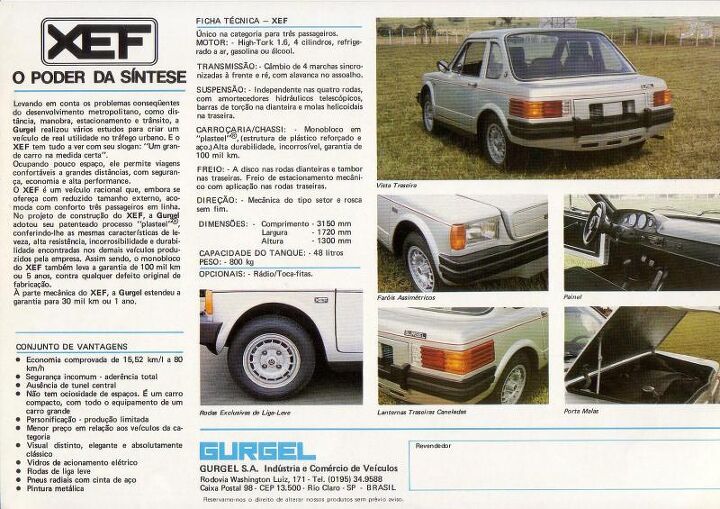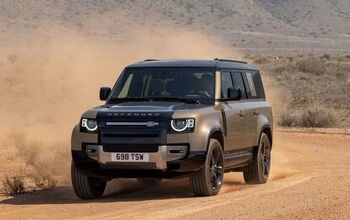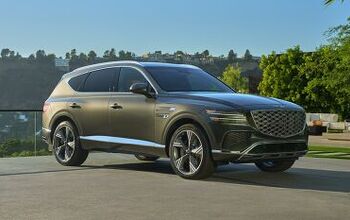Rare Rides: The 1985 Gurgel XEF, a Tiny and Obscure City Sedan

Today’s Rare Ride hails from an auto manufacturer you may have never heard of before: Gurgel. Made in Brazil, the conservative little XEF was an interesting side note in automotive history.
Gurgel Motores was founded in Brazil in 1969. Named after founder João do Amaral Gurgel, the brand focused on small off-road cars and buggies, initially all made of fiberglass. Not a large enough business to create its own platforms at the start, Gurgel attached its fiberglass body designs to Volkswagen Beetle chassis and engines.
In the early Seventies, Gurgel developed a new method of blending together fiberglass and steel to make Plasteel. The technology was designed and patented at Gurgel, and went into production on the Xavante off-roader in 1973. In addition to its Plasteel construction, the Xavante was fitted with individual hand brakes for each rear wheel installed next to the driver, a feature called Selectraction. The brakes stopped the wheel that lacked traction and moved power to the other rear wheel at the driver’s request. A manual limited-slip differential, if you will.
In addition to its off-road cars and buggies, Gurgel worked on urban electric cars in the early Seventies (the Itaipu). It also released a larger seven-passenger van called the X-15 in 1979. Entering into the city car space, development on the XEF began in 1981. The XEF was to be a new subcompact city car solution from Gurgel. It’s unclear when the car actually launched.
Shaped like a tiny Mercedes of the period, the XEF maintained a two-door sedan shape. It might be called a coupe except for the fact it had three-abreast seating at the front. Not in need of much power, the XEF used the air-cooled 1.6-liter engine from a Beetle. By that time Volkswagen had developed the engine to its final iteration, and it produced 60 horsepower.
The formal city car idea was not a successful one for Gurgel, and the company produced between 100 and 140 examples before it moved onto its most successful offering, the BR-800 city car. BR-800 held the distinction of being the first fully Brazilian-designed and manufactured car, as it did not use Volkswagen parts. We’ll save more BR-800 detail for another day, as it’s worth its own Rare Rides entry.
Today’s gold XEF is number 92 in the run, and its Plasteel construction has held up well. It’s yours for $21,500, and you’re sure never to see another one.
[Images: Gurgel]

Interested in lots of cars and their various historical contexts. Started writing articles for TTAC in late 2016, when my first posts were QOTDs. From there I started a few new series like Rare Rides, Buy/Drive/Burn, Abandoned History, and most recently Rare Rides Icons. Operating from a home base in Cincinnati, Ohio, a relative auto journalist dead zone. Many of my articles are prompted by something I'll see on social media that sparks my interest and causes me to research. Finding articles and information from the early days of the internet and beyond that covers the little details lost to time: trim packages, color and wheel choices, interior fabrics. Beyond those, I'm fascinated by automotive industry experiments, both failures and successes. Lately I've taken an interest in AI, and generating "what if" type images for car models long dead. Reincarnating a modern Toyota Paseo, Lincoln Mark IX, or Isuzu Trooper through a text prompt is fun. Fun to post them on Twitter too, and watch people overreact. To that end, the social media I use most is Twitter, @CoreyLewis86. I also contribute pieces for Forbes Wheels and Forbes Home.
More by Corey Lewis
Latest Car Reviews
Read moreLatest Product Reviews
Read moreRecent Comments
- GregLocock Why are you using your expensive limited lifetime EV battery rather than a cheap domestic one? Even the latter don't make sense financially in my area
- Ajla This may interest Mr. Posky. https://www.axios.com/2024/06/05/congestion-pricing-new-york-city-hochul-elections
- SCE to AUX I don't see the point. An EV that surrenders its energy to the grid still has to recover it later to drive.I'm also not a fan of regular V2L scenarios, because they cycle the vehicle's battery and contribute to its wear. Imagine using a PTO on your car's engine to plow a field or operate a sawmill, just because you could. You've consumed fuel you have to repurchase, and taken miles off the engine. No thanks.As a side note, your utility doesn't necessarily want your dirty power. It has to be converted back to precisely 60 Hz and high voltage, provided at a time when the grid actually needs it.
- Tane94 Puts the new 2025 Buick Enclave to shame, starting with its V-6 and opulent interior.
- MaintenanceCosts Seems nice enough if you want a boxy, poorly packaged off-road truck. I don't want a boxy, poorly packaged off-road truck.



































Comments
Join the conversation
I was born and raised in Brazil, so I really appreciate articles covering our forgotten and obscure, and this takes the cake. The Gurgel XEF went on sale in December 1983. Unlike the BR-800, this was meant to be an urban luxury type vehicle, priced around 15,000 USD at the time.
I feel a little bad for Mr. Gurgel. Of course, we must always be careful when piling sympathy onto historical figures, but having read a little about his story it sounds like he was a man of his ways, no matter the cost, and I can admire that. He kept building his little VW-powered cars of fiberglass and steel even if they were impractical, sold poorly, and were visually, uh, esoteric. One factoid sticks with me, though: I read that his company basically went south once the Brazilian government opened up trade borders in the '90s and the Niva undercut its Gurgel counterpart considerably despite there still being a trade tax. The implications there, to me, are both that the Niva was incredibly cheap, but also that Gurgels were incredibly expensive for what they were (without even offering 4x4!)